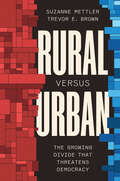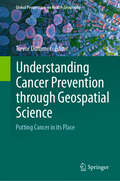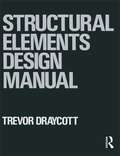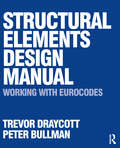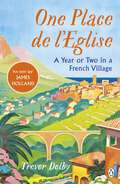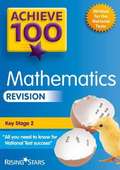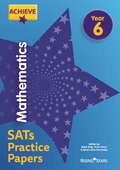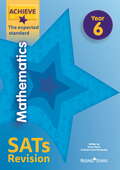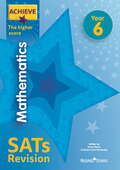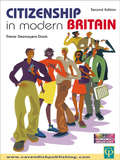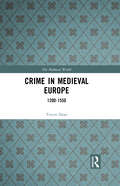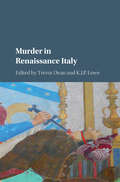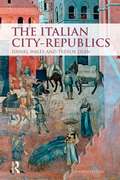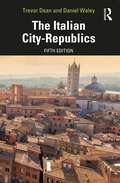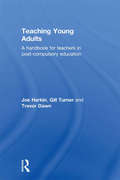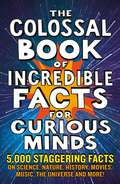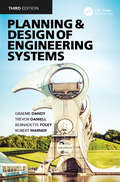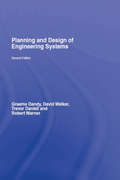- Table View
- List View
Rural Versus Urban: The Growing Divide That Threatens Democracy
by Suzanne Mettler Trevor E. BrownHow the urban-rural divide drives partisan polarization Why have Americans living in different places come to experience politics as a battle between &“us&” and &“them&”? In Rural Versus Urban, Suzanne Mettler and Trevor Brown argue that political polarization is not just about red states and blue states, or coastal elites who alienate those in fly-over country. Instead, polarization permeates every region and every state—and has become organized through a pernicious rural-urban division. Mettler and Brown explain the evolution of this gulf across five decades, charting political trends in both places. Drawing on data on individuals, communities, and members of Congress, as well as interviews with local party leaders and former elected officials, they show how the divide emerged and why it poses a threat to democracy.Until about thirty years ago, both political parties attracted support from rural and urban voters. But after place-based inequality grew due to deregulation and trade liberalization, white rural dwellers began to view urban people and Democrats as affluent elites out of touch with their needs. Politically active evangelical churches, antiabortion organizations, and gun groups helped deepen the divide, encouraging many of these rural residents to become staunch supporters of the GOP. Now, regional one-party rule in rural America gives Republicans a systematic edge for gaining control of crucial political institutions, including the Senate, House of Representatives, the Presidency, and even the Supreme Court. This is helping enable an extremist political party and pushing democracy to the brink. Mettler and Brown argue that the divide can be repaired—but only if the Democrats build their own robust local organizations and offer citizens a meaningful choice.
Understanding Cancer Prevention through Geospatial Science: Putting Cancer in its Place (Global Perspectives on Health Geography)
by Trevor DummerThe worldwide cancer burden will double over the next two decades, with the number of new cancer diagnoses increasing in all regions of the world. However, it is estimated that around 40% of all cancers are preventable through the appropriate application of existing epidemiological and public health knowledge, and with further research this proportion will increase considerably. This edited volume explores the role of place in cancer prevention and how geospatial tools can be used to support this globally important goal. Its chapters detail many aspects of the application of geospatial science to cancer control, including quantifying exposure to environmental carcinogens, access to screening services, the importance of partnership building, and more through a variety of geographically diverse case studies. The book also offers background on geospatial modeling tools and methods for adding spatial analysis to cancer surveillance systems. The book is rooted firmly in the notion that geography significantly influences the accumulation of cancer risks (at the individual and community level) that are modifiable through policy, regulatory, and behavioral changes. The landscape of cancer prevention is vast, encompassing the building blocks of population and public health—i.e., epidemiology and causation—through risk factor modifications, behavior and policy change, to the interface of the cellular with society, including epigenetic modifications and gene/environment interactions, cancer genomics and precision medicine/health. It is clear that geography (space, place, setting, context) is central to all these activities. Geospatial methods and data support risk factor identification, can elucidate the interaction between individual behavioral, demographic, and genetic factors with community level contextual factors, and can be used to prioritize interventions more accurately towards at-risk people and at-risk population groups. Geography is also central to the organization of health services and hence, by definition, is fundamental to the organization of preventative services. More broadly, adopting a geographical approach can help move cancer prevention beyond a narrow medical definition of health, to tackle the upstream and structural determinants of cancer.
Structural Elements Design Manual
by Trevor DraycottGives clear explanations of the logical design sequence for structural elements. The Structural Engineer says: `The book explains, in simple terms, and with many examples, Code of Practice methods for sizing structural sections in timber, concrete,masonry and steel. It is the combination into one book of section sizing methods in each of these materials that makes this text so useful....Students will find this an essential support text to the Codes of Practice in their study of element sizing'.
Structural Elements Design Manual: Working with Eurocodes
by Trevor Draycott Peter BullmanStructural Elements Design Manual: Working With Eurocodes is the structural engineers ‘companion volume’ to the four Eurocodes on the structural use of timber, concrete, masonry and steelwork. For the student at higher technician or first degree level it provides a single source of information on the behaviour and practical design of the main elements of the building structure. With plenty of worked examples and diagrams, it is a useful textbook not only for students of structural and civil engineering, but also for those on courses in related subjects such as architecture, building and surveying whose studies include the design of structural elements. Trevor Draycott the former Buildings and Standards Manager with Lancashire County Council’s Department of Property Services has 50 years experience in the construction industry. For 20 years he was also an associate lecturer in structures at Lancashire Polytechnic, now the University of Central Lancashire in Preston. For many years he served on the Institution of Structural Engineers, North West Branch, professional interview panel and the North West regional committee of the Timber Research and Development Association. Peter Bullman worked for Felix J Samuely and Partners, Taylor Woodrow Construction and Building Design Partnership before joining Bolton Institute, now the University of Bolton, as a lecturer in structural engineering. He has taught structural design on higher technician, degree and postgraduate courses, and has run courses to prepare engineers for the IStructE Chartered Membership examination.
One Place de l’Eglise: A Year in Provence for the 21st century
by Trevor DolbyEscape to Languedoc in this poignant and transportative true account of life in a beautifully restored house in the south of France'Wonderful, exquisitely written, laugh-out-loud funny, profoundly moving. An utter joy and a treat to read from first to last' JAMES HOLLAND'Dolby writes with genuine emotion. He writes beautifully about life in a French village' DAILY MAIL___________An Englishman's home is his castle. But what if it's French?One Place de L'Eglise is a thousand-year-old Languedoc ruin. Leaky, crumbling, lacking basic amenities, it is ignored by the local villagers. But for Londoners Trevor and Kaz it is love at first sight. Over the years they turn the house into a home, navigating floods and freezing winters. Here, these two English find their place - their bar, their baker, their builder (ignore him at your peril).And gradually they learn slower joys - scents of thyme and lavender, warm sun on stone, nights hung with stars, silence in the hills, the secrets of fig jam.One Place de L'Eglise is a love letter - to a house, a village, a country - from an outsider who discovers you can never be a stranger when you're made to feel so at home.___________'Irresistible, a timeless story' MICHAEL PALIN 'Elegant, captivating, and sprinkled with self-deprecating humour. Dolby is a writer of abundant talent' PETER KERR, author of Snowball Oranges
Shell Shock, Memory, and the Novel in the Wake of World War I
by Trevor DodmanShell Shock, Memory, and the Novel in the Wake of World War I explores the narrative traces, subaltern faces, and commemorative spaces of shell shock in wartime and postwar novels by Mulk Raj Anand, Ford Madox Ford, Mary A. Ward, George Washington Lee, Ernest Hemingway, F. Scott Fitzgerald and Christopher Isherwood. This book argues that World War I novels serve as an untapped source of information about shell shock, and renews our present understanding of the condition by exploring the nexus of shell shock and practices of commemoration. Shell shock novelists testify to the tenaciousness and complexity of the disorder, write survivors into visibility, and articulate the immediacy of wounds that remain to be seen. This book helps readers understand more fully the extent to which shell shock continues to shape and trouble modern memories of the First World War.
The Laws of Average
by Trevor DodgeIn 60 flash fictions, The Laws of Average celebrates the insanity of falling in love, the absurdity of playing by the rules, and the stupidities of discontent that ensnare us all.
Achieve 100 Maths Revision
by Trevor DixonA 72-page revision book that covers everything Year 6 children need to achieve 100 in the new National Tests. With a unique flowchart approach, this book not only covers all of the content that could be tested, it will show children how to answer test questions. Use alongside Achieve 100 Mathematics Practice Questions book.
Achieve 100 Plus Mathematics Revision
by Trevor DixonA 64-page revision book that covers the more demanding areas of the National Test to help more able Year 6 children fulfil their full potential. <P><P>With a unique flowchart approach, this book will show children how to answer test questions. Use alongside Achieve 100 Plus Mathematics Practice Questions.
Achieve Mathematics SATs Practice Papers Year 6 (Achieve Key Stage 2 SATs Revision)
by Trevor Dixon Steph King Solvemaths LtdAchieve. Fun and focused SATs revision.Achieve the Expected Standard in mathematics, with the only fully updated revision series. Written in the style of the most recent Year 6 National Tests, this essential book is packed with full length tests papers, providing realistic practice to develop and perfect exam technique for the 2019 SATs and covers everything that could be tested while ensuring children have some fun while they learn.Our unique approach has been helping children and schools perform above national average for over 15 years. This full colour write-in book:- Builds children's ability to concentrate in a test situation - Familiarises children with the style and format of the SATs with exposure to all the question types that could be set- Identifies strengths and weaknesses to help guide revision and improve results- Saves teacher and parent preparation time with ready-made practice papers- Draws on expert analysis to ensure our content is just right For best results use alongside Achieve Mathematics SATs Revision The Expected Standard Year 6 and Achieve Mathematics SATs Question Workbook The Expected Standard Year 6
Achieve Mathematics SATs Revision The Expected Standard Year 6 (Achieve Key Stage 2 SATs Revision)
by Trevor Dixon Solvemaths LtdAchieve. Fun and focused SATs revision.Achieve the Expected Standard in mathematics, with the only fully updated revision series. This book teaches children exactly how to tackle SATs questions (even the tricky ones) with confidence to get their best result. This book covers everything that could be tested while ensuring children have some fun while they learn.Our unique approach has been helping children and schools perform above national average for over 15 years. Children are guided step-by-step through all question types and easy-to-digest content is presented in a simple to follow format. Clear explanations and lots of practice make it the perfect revision range for use in school and at home. This revision book:- Teaches children how to tackle SATs questions ...and get them right!- Focuses revision for the greatest impact on final marks- Draws on expert analysis to ensure our content is just right - Provides full guidance by topic, and includes important facts, keywords, SATs terminology, tips and example practice questions - Offers digestible content and lots of opportunities to practise, making it perfect for use in school or at home For best results use alongside Achieve Mathematics SATs Question Workbook The Expected Standard Year 6 and Achieve Mathematics SATs Practice Papers
Achieve Mathematics SATs Revision The Higher Score Year 6 (Achieve Key Stage 2 SATs Revision)
by Trevor Dixon Solvemaths LtdAchieve. Fun and focused SATs revision.Achieve the Higher Score in mathematics, with the only fully updated revision series. This book teaches children exactly how to tackle the more demanding SATs questions with confidence to get their best result. For use with more able children, this book covers everything that could be tested and provides additional challenge while ensuring children have some fun while they learn.Our unique approach has been helping children and schools perform above national average for over 15 years. Children are guided step-by-step through all question types and easy-to-digest content is presented in a simple to follow format. Clear explanations and lots of practice make it the perfect revision range for use in school and at home. This revision book:- Focuses revision on the key information children need to reach the higher score- Shows children how to get full marks on extended questions- Teaches children how to answer test questions thoughtfully and appropriately- Offers digestible content and lots of opportunities to practise,making it perfect for use in school or at homeFor best results use alongside Achieve Mathematics SATs Question Workbook The Higher Score and Achieve Mathematics SATs Practice Papers
Citizenship In Modern Britain
by Trevor Desmoyers-DavisCitizenship in Modern Britain is a readable text that examines citizenship from a social science perspective. The subject matter has been divided into three sections,corresponding to each of the AQA AS Level modules. The text also provides all the necessary academic material required for examinable citizenship courses, supported and developed by a series of research, practical and discursive activities. These activities have been designed not only extend to students’ knowledge of the subject, but also to encourage thought, debate and evaluation. This book is essential for students taking AS level Citizenship. It also provides excellent support for students who are studying subjects that have close links to citizenship issues such as sociology, law, Government and politics and general studies.
Crime in Medieval Europe: 1200-1550 (The Medieval World)
by Trevor DeanWhat is the difference between a stabbing in a tavern in London and one in a hostelry in the South of France? What happens when a spinster living in Paris finds knight in her bedroom wanting to marry her? Why was there a crime wave following the Black Death? From Aberdeen to Cracow and from Stockholm to Sardinia, Trevor Dean ranges widely throughout medieval Europe in this exiting and innovative history of lawlessness and criminal justice. Drawing on the real-life stories of ordinary men and women who often found themselves at the sharp end of the law, he shows how it was often one rule for the rich and another for the poor in a tangled web of judicial corruption.
Crime in Medieval Europe: 1200-1550 (The Medieval World)
by Trevor DeanWhat is the difference between a stabbing in a tavern in London and one in a hostelry in the South of France? What happens when a spinster living in Paris finds knight in her bedroom wanting to marry her? Why was there a crime wave following the Black Death? From Aberdeen to Cracow and from Stockholm to Sardinia, Trevor Dean ranges widely throughout medieval Europe in this exiting and innovative history of lawlessness and criminal justice. Drawing on the real-life stories of ordinary men and women who often found themselves at the sharp end of the law, he shows how it was often one rule for the rich and another for the poor in a tangled web of judicial corruption.
Murder in Renaissance Italy
by Lowe Trevor Dean K. J. P.This invaluable collection explores the many faces of murder, and its cultural presences, across the Italian peninsula between 1350 and 1650. These shape the content in different ways: the faces of homicide range from the ordinary to the sensational, from the professional to the accidental, from the domestic to the public; while the cultural presence of homicide is revealed through new studies of sculpture, paintings, and popular literature. Dealing with a range of murders, and informed by the latest criminological research on homicide, it brings together new research by an international team of specialists on a broad range of themes: different kinds of killers (by gender, occupation, and situation); different kinds of victim (by ethnicity, gender, and status); and different kinds of evidence (legal, judicial, literary, and pictorial). It will be an indispensable resource for students of Renaissance Italy, late medieval/early modern crime and violence, and homicide studies.
The Italian City Republics
by Trevor Dean Daniel Philip WaleyDaniel Waley and Trevor Dean illustrate how, from the eleventh century onwards, many dozens of Italian towns achieved independence as political entities, unhindered by any centralising power. Until the fourteenth century, when the regimes of individual ‘tyrants’ took over in most towns, these communes were the scene of a precocious, and very well-documented, experiment in republican self-government. Focusing on the typical medium-sized towns rather than the better-known cities, the authors draw on a rich variety of contemporary material (both documentary and literary) to portray the world of the communes, illustrating the patriotism and public spirit as well as the equally characteristic factional strife which was to tear them apart. Discussion of the artistic and social lives of the inhabitants shows how these towns were the seed-bed of the cultural achievements of the early Renaissance. In this fourth edition, Trevor Dean has expanded the book’s treatment of religion, women, housing, architecture and art, to take account of recent trends in the abundant historiography of these topics. A new selection of illuminating images has been included, and the bibliography brought up to date. Both students and the general reader interested in Italian history, literature and art will find this accessible book a rewarding and fascinating read.
The Italian City-Republics
by Daniel Waley Trevor DeanNow in its fifth edition, The Italian City Republics illustrates how, from the eleventh century onwards, many Italian towns achieved independence as political entities, unhindered by any centralising power. Until the fourteenth century, when the regimes of individual ‘tyrants’ took over in most towns, these communes were the scene of a precocious, and very well-documented, experiment in republican self-government. In this new edition, Trevor Dean has expanded the book’s treatment of women and gender, the early history of the communes and the lives of non-élites. Focusing on the typical medium-sized towns rather than the better-known cities, the authors draw on a rich variety of contemporary material, both documentary and literary, to portray the world of the communes, illustrating the patriotism and public spirit as well as the equally characteristic factional strife which was to tear them apart. Discussion of the artistic and social lives of the inhabitants shows how these towns were the seedbed of the cultural achievements of the early Renaissance. The Bibliography has been updated to a list of Further Reading with the latest scholarship for students to continue their studies. Both students and the general reader interested in Italian history, literature and art will find this accessible book a rewarding and fascinating read.
Teaching Young Adults: A Handbook for Teachers in Post-Compulsory Education
by Trevor Dawn Joe Harkin Gill TurnerFurther and Higher Education in the UK has expanded greatly in recent years, bringing into education large numbers of young people who present teachers with new challenges. At the same time, there is an immense pressure to improve the quality of learning and teaching, and to encourage students to be active participants in the process. This book is aimed at teachers, aspiring teachers and other professionals in upper secondary schools, further education colleges and universities who wish to increase learner motivation and to create opportunities for greater learner autonomy. It will:* relate learning theory to practice* provide practical help for teachers to understand how they tend to interact with students* suggest how they may build a repertoire of teaching styles that foster sharing of responsibility with learners for more effective learning.
The Colossal Book of Incredible Facts for Curious Minds: 5,000 staggering facts on science, nature, history, movies, music, the universe and more!
by Chas Newkey-Burden Nigel Henbest Sarah Tomley Simon Brew Ken Okona-Mensah Tom Parfitt Trevor DaviesA polish bear in World War II rose to the rank of colonel.Penguins can't taste fish.The ashes of the man who invented the Pringles container are buried in one one.On Neptune it rains diamonds.'Hippopotomonstrosesquippedaliophobia' is the fear of long words. These are just 0.1% of all the facts in this incredible tome! Written by seven authors and covering subjects as diverse as The Universe, Art and Literature, The Natural World and Movies, The Colossal Book of Incredible Facts for Curious Minds is the ultimate trivia book! Why not amaze family and friends with the reasons pandas do handstands, the sinister source of the term 'rule of thumb', or that the patent for the fire hydrant was destroyed... in a fire. Every entry is weird, wonderful, inspiring and quite brilliantly, true!
The Colossal Book of Incredible Facts for Curious Minds: 5,000 staggering facts on science, nature, history, movies, music, the universe and more!
by Chas Newkey-Burden Nigel Henbest Sarah Tomley Simon Brew Ken Okona-Mensah Tom Parfitt Trevor DaviesA polish bear in World War II rose to the rank of colonel.Penguins can't taste fish.The ashes of the man who invented the Pringles container are buried in one one.On Neptune it rains diamonds.'Hippopotomonstrosesquippedaliophobia' is the fear of long words. These are just 0.1% of all the facts in this incredible tome! Written by seven authors and covering subjects as diverse as The Universe, Art and Literature, The Natural World and Movies, The Colossal Book of Incredible Facts for Curious Minds is the ultimate trivia book! Why not amaze family and friends with the reasons pandas do handstands, the sinister source of the term 'rule of thumb', or that the patent for the fire hydrant was destroyed... in a fire. Every entry is weird, wonderful, inspiring and quite brilliantly, true!
Darker Than the Deepest Sea: The Search for Nick Drake
by Trevor DannWhen Nick Drake (1948-1974) died of a drug overdose at twenty-six, he left behind three modest-selling albums, including the stark Pink Moon and the lush Bryter Layter. Three decades later, he is recognized as one of the true geniuses of English acoustic music. Yet Nick Drake--whose music was as gentle and melancholy as the man himself-- has always maintained a spectral presence in popular music. This groundbreaking biography reconstructs a vanished life while perfectly capturing the bohemian scenes surrounding the music business in London in the late '60s and early '70s. Using many newly discovered documents and all-new interviews, Trevor Dann reveals more detail on Nick Drake than ever, from his upbringing in a quintessentially English village, through his hash-fueled school days at Cambridge University, to the missed opportunities and mismanagement that defined his career. Friends and colleagues describe the difficulties that he faced as each new album was released, only to fail, and the insidious despair that consumed him. Complete with discography and rare photos, Darker Than the Deepest Sea is essential reading for anyone who has been moved by Nick Drake's unforgettable blend of beauty and sadness.
Planning and Design of Engineering Systems (Third Edition)
by Robert Warner Graeme Dandy Trevor Daniell Bernadette Foley<p>This newly updated book offers a comprehensive introduction to the scope and nature of engineering work, taking a rigorous but common sense approach to the solution of engineering problems. The text follows the planning, modelling and design phases of engineering projects through to implementation or construction, explaining the conceptual framework for undertaking projects, and then providing a range of techniques and tools for solutions. It focuses on engineering design and problem solving, but also involves economic, environmental, social and ethical considerations. <p>This third edition expands significantly on the economic evaluation of projects and also includes a new section on intractable problems and systems, involving a discussion of wicked problems and soft systems methodology as well as the approaches to software development. Further developments include an array of additional interest boxes, worked examples, problems and up-to date references. <p>Case studies and real-world examples are used to illustrate the role of the engineer and especially the methods employed in engineering practice. The examples are drawn particularly from the fields of civil and environmental engineering, but the approaches and techniques are more widely applicable to other branches of engineering. <p>The book is aimed at first-year engineering students, but contains material to suit more advanced undergraduates. It also functions as a professional handbook, covering some of the fundamentals of engineering planning and design in detail.</p>
Planning and Design of Engineering Systems, Second Edition
by David Walker Robert Warner Graeme Dandy Trevor DaniellProviding students with a commonsense approach to the solution of engineering problems and packed full of practical case studies to illustrate the role of the engineer, the type of work involved and the methodologies employed in engineering practice, this textbook is a comprehensive introduction to the scope and nature of engineering. It outlines a conceptual framework for undertaking engineering projects then provides a range of techniques and tools for solving the sorts of problems that commonly arise. Focusing in particular on civil engineering design, problem solving, and the range of techniques and tools it employs, the authors also explore: creativity and problem solving, social and environmental issues, management, communications and law, and ethics the planning, design, modelling and analysis phases and the implementation or construction phase. Designed specifically for introductory courses on undergraduate engineering programs, this extensively revised and extended second edition is an invaluable resource for all new engineering undergraduates as well as non-specialist readers who are seeking information on the nature of engineering work and how it is carried out.
